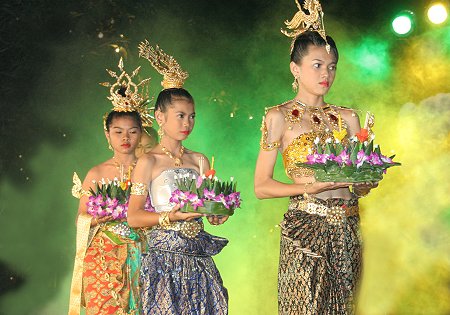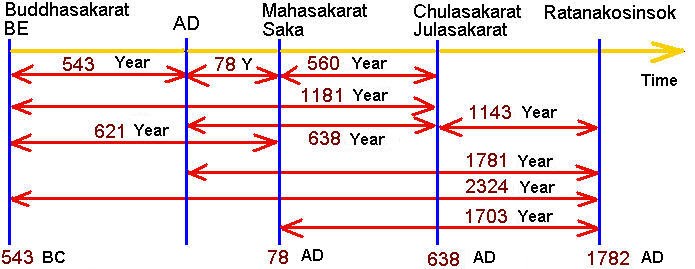
Thai calendars show both Buddhist Era and Christian Era dates. They also have another set of dates which belongs to the old system which calculates the Thai Lunar Months. This is when it gets complicated. Lunar months do not match the solar calendar. For example, although we are now in August which is the 8th month, it is in fact the 9th lunar month. So, why is important to still show the lunar calendar although it hasn’t been used officially for several hundred years? Well, all Buddhist holidays and festivals are based on the Thai lunar calendar. It tells people which day of the week is “wan phra” or the holy day and which days we should celebrate holidays such as Khao Phansa and Loy Krathong.

One of the questions we often get at ThailandQA.com Forums is when will Loy Krathong be celebrated this year or the next. This is because many of these holidays are not fixed by the solar calendar. Here are the official dates according to the lunar calendar:
Magha Puja Day – full moon day of the third lunar month
Ashana Puja Day – on the fifteenth day of the waxing moon of the eighth lunar month
Khao Phansa – on the first day of the waning moon of the eighth lunar month
Loy Krathong – on the full moon night of the twelfth lunar month
Phra Samut Chedi Temple Fair – on the fifth day of the waning moon in the eleventh lunar month
A complete cycle of the moon, from the new moon (dark moon) to the full moon is 29 and a half days. To make up for this, months alternate between 29 days and 30 days. Like I said before, August this year is the 9th lunar month. It has 15 days of waxing moon (known in Thai as “keun”) and 14 days of waning moon (known in Thai as “raem”). Next month has an equal 15 days of waxing and 15 days of waning. For most of us, today is Thursday 21st August. But, on my lunar calendar, it is “5 raem 5 kam deuan 8?. The first “5? is for the 5th day of the week which is Thursday. Then “raem 5? is the 5th day of the waning moon. Finally, “deuan 8? translates as the 8th month. I should also mention that “kam” refers to the period starting after sunset and not the start of the day.

Let’s take a look at some of the festivals mentioned above. First an easy one. Loy Krathong is celebrated every year on the full moon night of the 12th lunar month. The 12th lunar month is usually in November though it is sometimes earlier. This year, the full moon is on 12th November 2008. In Thai this is “keun 15 kam deuan 12?. For the next example, we will take the start of the Buddhist Rains Retreat which is called Khao Phansa. This starts on the first day of the waning moon of the eighth lunar month. This year, the 8th lunar month started on 3rd July. In Thai, waning is “raem” which is the period after a full moon. This happened on 17th July and so the next day is then “raem 1 kam deuan 8?.
After a while it does become easier. You just need a Thai calendar that marks the lunar months. To find out the dates for the Buddhist festivals and Loy Krathong for next year, it is possible to buy 100 year calendars. However, be warned, they have made mistakes in their calculations before and some years we celebrate major Buddhist holidays on the wrong day!
Buddhist Era (B.E.): The official year in Thailand is counted from the death of the Buddha. The year the Buddha passed away is 0 B.E. To convert from A.D. to B.E., one can generally add 543. For example, the year 2000 A.D. would be 2543 B.E. in Thailand. Although the Buddhist Era dates are widely used, most people are aware of the Gregorian dates. In neighboring India, Sri Lanka, and Burma the date of the Buddha’s passing is counted as 1 B.E., however in Thailand, Laos, and Cambodia it is counted as 0 B.E.

No comments:
Post a Comment